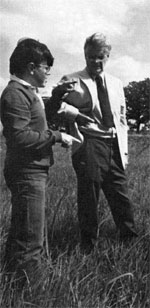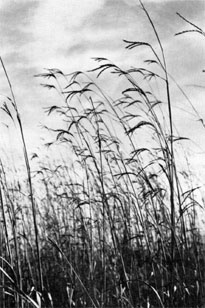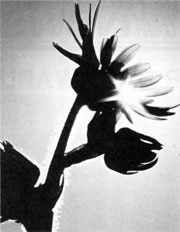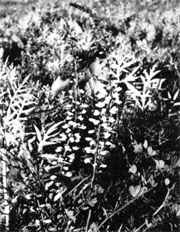Prairie project takes step backward
Robert Wilson, Director Emeritus and the original stimulus behind the Fermilab prairie restoration, watches Tony Donaldson (left), former Prairie Committee chairman gesticulate about the height of the prairie grasses in the Main Ring in June 1982, compared to the 6 to 8 feet height of big bluestem grass in September 1981 (photo on right).
Big bluestem is one of the most important and tallest of the prairie grasses and the species is well represented in the Main Ring plantings.
The Fermilab Prairie Project took another big step backward last year. Sixty more acres of land inside the Main Ring were started on their way back to prairie, the community of grasses, wildflowers, and animals that flourished here before European settlement began. Over half of the land in the Main Ring has been planted in prairie grass already; in just three or four years prairie grasses will have "recaptured the ground" throughout the Main Ring.
Prairie grasses are amazing plants. If you visit the prairie in August or September, you will understand why the pioneers were impressed as they tried to wind their way through thick stands of big bluestem grass and Indian grass towering over their heads. Prairie grasses are also tough plants; they do well against weedy competitors, weakening them and driving them out. They also produce lots of fuel for roaring prairie fires which stimulate prairie plants but stunt and kill most weedy annuals, trees, and brush.
But prairie is more than just grasses. Prairies in this area probably had about 150 species of wildflowers. In the spring, the prairie violet and the shooting star carpeted the ground. A bit later, spider-worts, cream wild indigos, wild quinines, and purple coneflowers bloom. As fall approaches and the grasses tower overhead, the prairie docks and compass plants, with their bright yellow flowers at the top of ten- or twelve-foot stalks, will be visible even above the grasses. Finally, late in the fall, gentians and other late bloomers appear.
A few vigorous wildflowers are planted alongside the grasses. They too are hardy and thrive against weeds. Many other prairie plants are more finicky about where they will grow; they do well only after the basic prairie matrix is already established. Each year additional wildflowers are planted. Some seeds are scratched into open areas, some are grown into young plants in greenhouse flats and transplanted. Some species do well; some are notoriously hard to start.
If you visit the prairie during June and early July, before the grasses have grown so tall that they obscure everything else, you can see over twenty kinds of prairie wildflowers growing in the earliest prairie planting, which was sowed in 1975. Later plots have fewer species; prairie plants are almost all perennials and may take years to bloom. 'Last year's planting looks like a catalog of horrible weeds, but underneath, the prairie plants are emerging. In a few years, they will vanquish the weeds and furnish a prairie-like environment into which more species can be added. Every year we make an effort to improve every plot. It's a long road backward to a fully restored prairie.
Plants are only part of the story; the prairie also had its own animals. Some return by themselves as the habitat becomes more like prairie; several kinds of birds have become much more common in recent years, and some prairie insects are showing up. Some animals, almost extinct in this area through excessive hunting and destruction of living space, must be reintroduced. In 1982, trumpeter swans were in the marshes inside the prairie; these birds were captive, but their young were free-flying wild birds.
As the years have passed, new planting techniques have been tried. Some have been successful, others have failed. We are still studying the best methods to use in restoring such enormous areas. Some areas are thoroughly plowed and disked; in others minimal tillage or none at all is necessary. Some planting has been done with a modified grain drill, some with a hydroseeder, and some using the salt spreader used for salting Fermilab roads in the winter. One thing that remains constant is our need for volunteers to pick wildflower seeds, plant them in our plots, and help with the combining and planting of grass seed in the fall.
The best way to get a feeling for the Fermilab prairie is surely a visit; any prairie committee member will be glad to give you a guided tour. Visitors should be warned of prairie fever, an incurable progressive disease that afflicts even an occasional casual visitor. Symptoms are various sorts of seemingly bizarre behavior - incessant plucking of dried seed heads, searching for rare plants in old cemeteries and along railroad tracks, planting funny-looking seeds in big open fields, and walking around through prairie tracts talking in a strange mixture of English and Latin. It's a great disease once you get used to it!







